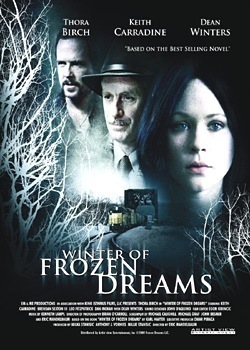
WINTER OF FROZEN DREAMS
US, 2009, 88 minutes, Colour.
Thora Birch, Keith Carradine, Brendan Sexton III.
Directed by Eric Mandelbaum.
Winter of Frozen Dreams is based on a true story, the first murder trial televised in the United States (though this is not indicated in the film itself). The film opens with a guilty verdict on Barbara Hoffman, played by Thora Birch who made an impression in American Beauty, Ghost World and other films of the 1990s.
The film is a combination of flashbacks and flashbacks within flashbacks – which does not make it always easy to follow. The film shows Barbara Hoffman as a student who dropped out to become a prostitute, indulging in a relationship with a factory worker, aiming to be his fiancée, getting him to make over all his possessions to her. He is then murdered. She enlists the help of another fiancé, Jerry Davies (Brendan Sexton III) who helps her dispose of the body. He then goes to the police.
The film moves backwards and forwards, showing Barbara’s developing relationship with the factory worker and persuading him to sign over everything to her. It also goes back to her relationship with Jerry, posing as his fiancée, also getting him to take out a life insurance policy with her as beneficiary. He also dies – but it is open whether she killed him, he killed himself, or accidentally killed himself.
Barbara Hoffman has been in prison for thirty years and has refused to give any interviews whatsoever.
A strong feature of the film is the performance by Keith Carradine as a detective, hat-wearing and pipe-smoking, about to retire and his interactions with the district attorney and his assistant whom he is training. He has a sardonic tone in his manner, with tongue-in-cheek humour.
The film doesn’t explain many of the factors and complexities in the case, which audiences would be worrying about. However, it leaves some aspects open ended, and the film is carried by the performances as well as the wintry photography in Wisconsin.
1. Audience interest in the case? A true story? The case as televised for the American public? The refusal of Barbara Hoffman to do any interviews and her remaining in prison for decades.
2. The title, the Wisconsin winter, snow and ice, Christmas Day, January into February, Valentine’s Day? The frozen atmosphere? The musical score?
3. The setting in 1980 and the flashbacks to 1977 and the ensuing years? The atmosphere of the period? Its look?
4. The portrait of Barbara Hoffman, Thora Birch’s performance? Her age, background, biochemistry student, high IQ, her explanations of why she dropped out and became a prostitute, doing phone sex calls for money, knowing the women, joining them, intending to get out, to make money? Jerry and his questioning her about all of this, and her saying that this was what she told people – and the question whether this was true or not? Her work as a prostitute, her glamour, her being employed by Ken Curtis? His relationship with her, coming to her room? Her toying with him? Her jealousy of his entanglements with other women, clawing the rival girl? The audience seeing her as judged guilty at the opening of the film, how much did this influence interpretation of her actions? Her character? Seeing her dispose of the body in the snow with Jerry? Her relationship with Harry Berge, his background, his phoning her, the sadomasochistic background, her tantalising him, suddenly appearing at the bowling club as his fiancée, the change of name? Going to the lawyer, Harry’s infatuation with her, her acting the part? His death? Her relationship with Jerry, fiancée, going to meet his mother and charming her? Their talks, outings together, his helping her dispose of the body? Her various stories – especially about Ken Curtis murdering the client and dumping the body to frame her? Her earnestness with Jerry, the revelation about the policy, his meal and her preparation of it, other times leaving him waiting for hours for Valentine’s Day restaurant bookings? His awareness of her drugs? Her reaction to drug-taking? His death? Whether she was guilty or not? How insightful a portrait of this complex young woman?
5. Jerry Davies, his age, experience, jobs, the university? Infatuation with Barbara, talking with her, the outings? Helping her with the body? Going to the police, the cross-examination? The police following him and Barbara’s telling one of the police off? His relationship with his mother? His collaboration with Detective Lulling? His final talk with Barbara, the mystery of why she worked in the way that she did? Her drugs? His death in the bath?
6. Harry Berge, seeing him at work, silent, going home, lonely? The background of his sister, nieces and nephews, the model train, his love for them? His dependence on Barbara, the masochistic aspects and the photo in the book? His dating her, the bowling club and his friends, the revelation about his fiancée, going to the lawyer, not taking the lawyer’s advice about his will? His death?
7. Detective Lulling, at the end of his career, the hat, the pipe, the reference to Sherlock Holmes and detection? His assistant and training him, the assistant asking questions? The relationship with the DA? The interrogation of Jerry, finding the body, taking Barbara in, the questions? The visit to Curtis, the background of his brothel and the prostitutes? His explanation of himself and his partner?
8. Incidental characters building up a background, Jerry’s mother, the meal? The neighbour objecting to the noise, Jerry and Barbara watching the films? Urging the police to inquire – and finding Jerry dead? The fellow workers from the factory? The young people? The women at the brothel?
9. True story, of interest in terms of criminology, of psychological studies of criminals?